Ford Thunderbird
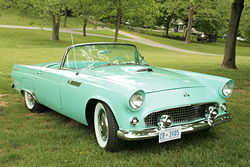 |
|
| Manufacturer | Ford Motor Company |
|---|---|
| Production | 1955-1997 2002-2005 |
| Class | Personal luxury car |
| Layout | FR layout |
The Thunderbird is an automobile manufactured by the Ford Motor Company in the United States from 1955 through 2005 — through thirteen generations and various body types.
The name "Thunderbird" was inspired by the name of an exclusive housing development and recalls the mythological creature common to Indigenous peoples of North America.
Contents |
Overview
The car entered production for the 1955 model year as a two-seater sporty car but unlike the Chevrolet Corvette, was never sold as a full-blown sports car. Ford named a new market segment by calling the Thunderbird a personal luxury car. In 1958, the Thunderbird gained a second row of seats. Succeeding generations became larger until the line was downsized in 1977, again in 1980, and once again in 1983. Sales were good until the 1990s, when large 2-door coupes became unpopular; production ceased after 1997. In 2002, a revived 2-seat model was launched, which was available through the end of the 2005 model year.
Genesis
A smaller two-seater sports roadster was created at the behest of Henry Ford II in 1953 called the Vega. The completed one-off generated interest at the time, but had meager power, European looks, and a correspondingly high cost, so it never proceeded to production. The Thunderbird was similar in concept, but would be more American in style, more luxurious, and less sport-oriented.
Three men are generally credited with creating the original Thunderbird: Lewis D. Crusoe, a retired GM executive lured out of retirement by Henry Ford II; George Walker, chief stylist and a Ford vice-president; and Frank Hershey, a Ford designer. Crusoe and Walker met in France in October 1951. Walking in the Grand Palais in Paris, Crusoe pointed at a sports car and asked Walker, 'Why can’t we have something like that?' Some versions of the story claim that Walker replied by telling Crusoe, "oh, we're working on it"...although if anything existed at the time beyond casual dream-car sketches by members of the design staff, records of it have never come to light.
Walker promptly telephoned Ford's HQ in Dearborn and told designer Frank Hershey about the conversation with Crusoe. Hershey took the idea and began working on the vehicle. The concept was for a two-passenger open car, with a target weight of 2525 lb (1145 kg), an Interceptor V8 engine based on the forthcoming overhead-valve Ford V8 slated for 1954 model year introduction, and a top speed of over 100 mph (160 km/h). Crusoe saw a painted clay model on May 18, 1953, which corresponded closely to the final car; he gave the car the go-ahead in September after comparing it with current European trends. After Henry Ford II returned from the Los Angeles Auto Show (Autorama) in 1953 he approved the final design concept to compete with the then new Corvette.
Unlike the Corvette, the Thunderbird was never a full-blown sporting vehicle; Ford's description was personal luxury car, and the company essentially created this market segment.
Naming
There was some difficulty in naming the car, with suggestions ranging from the exotic to the ridiculous (Hep Cat, Beaver, Detroiter, Runabout, Arcturus, Savile, El Tigre, and Coronado). Crusoe offered a $250 suit to anyone who could come up with a better name.
Stylist Alden "Gib" Giberson submitted Thunderbird as part of a list. Giberson got the idea during a lightning storm when he saw an illusion of a bird getting hit by lightning, but this happened because of his view. Giberson never claimed his prize, settling for a $95 suit and an extra pair of trousers from Saks Fifth Avenue.
According to Palm Springs Life magazine, the car's final name came not from the Native American symbol as one might expect, but from an ultra-exclusive housing tract in what would later be incorporated as Rancho Mirage, California: Thunderbird Heights.
Prior to naming the car the Thunderbird, Ford asked and was granted permission to do so from Triumph Motorcycles in England who had a Thunderbird model motorcycle of their own at the time.
Generations
1955-1957
 |
|
| Production | 1955-1957 |
|---|---|
| Assembly | Dearborn, Michigan |
| Body style(s) | 2-door convertible 2-door coupe |
| Engine(s) | 292 cu in (4.8 L) Y-block V8 312 cu in (5.1 L) Y-block V8 |
The car was shown at the Detroit Auto Show on February 20, 1954. The first production car came off the line on September 9, 1954, and went on sale on October 22, 1954 as a 1955 model, and sold briskly; 3,500 orders were placed in the first ten days of sale. Ford had only projected building 10,000; eventual 1955 sales were 16,155.
As standard, the 1955 Ford Thunderbird included a removable fiberglass top; a fabric convertible top was an option, although commonly specified. The engine was a 292 Y-block V8. The car had fender skirts. The exhaust pipes exited through twin bumper guards, which are bolted to the rear bumper.
Created to act as a retort to the Chevrolet Corvette, it was also the first mass produced edition of all the Ford Thunderbird models. Exactly 53,166 models were produced. It was produced with a Fordomatic or Overdrive transmissions, and featured four-way powered seats and pushbutton interior door handles.
Equipped with a V8 engine, the Thunderbird could hit 110-120 mph. It was a smaller two-seat "personal luxury car", compared to the wallowing barges that roamed all the roads in the 1950s. It was designed to be a brisk luxury tourer, and not a sports car.
For the 1956 model, more trunk space was added, the spare wheel was mounted outside, the exhausts were moved to the ends of the bumper, and air vents were added behind the front wheels to improve cabin ventilation. To improve rear-quarter visibility with the removable hardtop in place, "porthole" windows were made available as a no-cost option. An optional 312 Y-block V8 was made available for those that wanted more performance. 1956 sales were 15,631, the lowest of all three 2-seater Thunderbird model years.
For 1957, a more radical restyle was performed. The front bumper was reshaped, the grille and tailfins were made larger, and larger tail-lights were fitted. The spare wheel moved inside the trunk again, which had been redesigned to allow it to be mounted vertically. The side "Thunderbird" script moved from the fins to the front fenders. As well as the standard 292 and 312 engines, versions of the 312 were produced in higher states of tune, and even a few McCulloch supercharged versions, rated at 300 and 340 hp (254 kW) respectively. 1957 sales were 21,380, including three extra months of production because the 1958 models were late. The 1957 Thunderbird would be the last two-seater Ford ever built and sold to the public until the 1982 Ford EXP sport compact car.
1958-1960
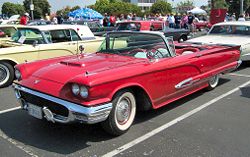 |
|
| Production | 1958-1960 |
|---|---|
| Assembly | Wixom, Michigan |
| Body style(s) | 2-door hardtop coupe 2-door convertible |
| Engine(s) | 352 cu in (5.8 L) FE V8 430 cu in (7 L) MEL V8 |
| Transmission(s) | 3-speed manual 3-speed automatic |
Although the original Thunderbird was successful, the corporation's executives -- particularly Robert McNamara -- felt its sales volume was small. Market research suggested that sales were limited by its two-seat configuration, making it unsuitable as an only car for families. The second generation, introduced for the 1958 model year, was designed as a four-seat car.
The four-seat Thunderbird was designed with unibody construction, eschewing a separate chassis. The intent was to allow the maximum interior space in a relatively small exterior package. The new Thunderbirds were produced at a new assembly plant at Wixom, Michigan, built as part of a corporate expansion plan to increase the sales of up-market cars (Mercurys, Lincolns, and Thunderbirds).
The new Thunderbird had a distinct new styling theme. The design was driven entirely by the styling department and approved before the engineering was considered. The design was one of two proposed, styled primarily by Joe Oros, who later worked on the Ford Mustang; the losing proposal, by designer Elwood Engel, was reworked in size to become the 1961 Lincoln Continental.
The new Thunderbird was nine inches (230 mm) lower than the standard American car of the time, at 52.5 in (1.33 m), with only 5.8 in (147 mm) of ground clearance. The significant transmission tunnel intrusion required to fit the powertrain into such a low car was turned into a styling feature by covering it with a large, full-length center console dividing the front and rear seats and containing ashtrays, switches, and minor controls.
Beneath the monocoque construction, the remainder of the engineering was conventional. Ford's new FE-series engine was used, with 352 cu in (5.8 L) displacement. Standard transmission remained a three-speed manual transmission, with optional overdrive or Cruise-O-Matic three-speed automatic transmission. Front suspension was independent, with coil springs and unequal-length A-arms. The rear was initially a live axle suspended by coil springs, which were intended to be interchangeable with optional air springs that were canceled before production. Drum brakes were used at all four wheels.
Various delays conspired to have production start only on December 20, 1957, much later than the normal September start; the 1957 Thunderbird was thus built for three extra months.
The new Thunderbird captured Motor Trend's Car of the Year award in its debut season. While many fans of the earlier, two-seat Thunderbirds were not happy with the new direction, Ford was vindicated with sales figures of 37,892, more than double the previous year despite losing three months of production and 1958 being a very poor year for car sales—the Thunderbird was one of only two cars to show a sales increase that year (the other being the Rambler). Only 2,134 convertibles were built, mostly because the convertible model did not become available until June 1958.
For the 1959 model year, Ford made changes to the front, rear, and side ornamentation, and made leather upholstery available for the first time. The rear suspension was revised, discarding coil springs for Hotchkiss drive, with parallel leaf springs. A new engine, the 430 cu in (7 L) MEL-series, was available in small numbers. Sales almost doubled again, to 67,456 units, including 10,261 convertibles. Thunderbird advertising in 1959 targeted women in particular, showing glamorous models in country club and other exclusive settings, and the sales figures bore out Ford's marketing plans.
With more trim changes, 1960's sales figures hit another record: 92,843 units sold, including 11,860 convertibles. A rare option in this year was a sunroof; this "Golde Edition" (Golde was a German company whose sunroof patent Ford licensed) sold 2,530 examples.
At the end of 1960 production two Thunderbirds were constructed of stainless steel for the Allegheny Ludlum Steel Corporation, at a price of $35,000 each. Because of the properties of stainless steel, the production dies would be destroyed as a result of the stamping of the parts. This was not a problem for Ford, as the next generation of T-Bird used a new body style. To duplicate the T-Birds 3,957 lb. normal production weight, body panels were made of Type 302 stainless steel, and trim pieces out of Type 430 stainless steel. At the time of their production, because of the maximum rolling mill for stainless steel only produced stock that was 72 inches in width, both cars' roofs were constructed from two 42-inch-wide sections which were welded together in the middle (the roof would have required an 84-inch-wide sheet of stainless steel, which apparently could not be obtained). Both T-Birds received mechanical and interior restorations in the 1980s and survive to this day, with one on permanent display at the Heinz History Center in Pittsburgh, PA.
1961-1963
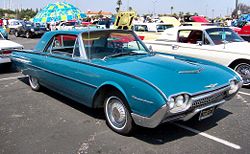 |
|
| Production | 1961-1963 |
|---|---|
| Assembly | Wixom, Michigan |
| Body style(s) | 2-door hardtop coupe 2-door convertible |
| Engine(s) | 390 cu in (6.4 L) FE V8 |

1961 saw new and much sleeker styling. Sales were strong, if not quite up to record-breaking 1960, at 73,051 including 10,516 convertibles. A new, larger 390 cu in (6.4 L) FE-series V8 was the only engine available (in 1961). The Thunderbird was 1961's Indianapolis 500 pace car, and featured prominently in US President John F. Kennedy's inaugural parade, probably helped along by the appointment of Ford executive Robert McNamara as Secretary of Defense.
The Thunderbird for 1961 introduced several firsts for the automotive market. The most distinctive feature of the 1961 to 1963 Thunderbirds was the highly touted 'Swing Away' steering wheel. With the transmission in the park position the steering wheel would slide approximately 18 inches to the right allowing the driver to exit the vehicle easily. Other innovations include a floating rear view mirror. Common on all autos produced today, this feature was first found on 1961 Thunderbirds. Depending on variable options Thunderbirds for 1961 could be purchased with options like air conditioning, power windows, power seats, AM radio, fender skirts and white wall tires. Several standard features, like power steering and power brakes, back up lights and bucket seats were costly options on most other autos.
1962 saw strong production figures of 78,011 (including 9,884 convertibles) and the introduction of the Thunderbird Sports Roadster. The Sports Roadster was a limited production version of the convertible which added 48 spoke Kelsey Hayes designed wire wheels, special badges to the front fenders and a passenger side grab bar to the front dashboard. The most striking addition to the Sports Roadster was a fiberglass tonneau cover which covered the back seat of the car and created a two seater appearance. 1,427 Sports Roadsters were produced in 1962, including 120 models with the special M Code option noted below. Early models suffered from problems related to their specially designed wire wheels. The problem was quickly corrected when Elvis Presley was involved in an accident when one of the Kelsey Hayes wheels collapsed during hard turning.
Another addition for 1962 was a special engine code (VIN engine code M) which added a tripower or three two barrel setup to a higher compression version of the Ford 390CI engine. This engine used 406 heads as well as the same carburetors that were found on the high performance 406 powered Ford Galaxies but with a modified version of the intake manifold to allow for proper air flow under the engine. This engine boasted 345 hp (257 kW) but was considered a moderate failure. The engine option was quietly discontinued halfway through the mid 1963 production run.
Also introduced in 1962 was the Landau model, with a vinyl roof and simulated S-bars on the rear pillars. This was the beginning of the 1960s/1970s fashion for vinyl roof treatments, and a vinyl roof was a popular Thunderbird feature for the next twenty years.
Changes for 1963 were relatively mild. Some additions to the option list included vacuum assisted door locks and an AM/FM radio and a remote power drivers side mirror became standard. 1963's numbers were down at 63,313. The Landau became the number 2 model after the standard hardtop, at 12,193 sold. Landaus added simulated wood grain trim to go along with the landau top. In addition a Limited Edition "Principality of Monaco" Landau model was introduced. This Corinthian White car, with a white leather interior was personalized with a plaque displaying the owner's name and the car's limited production number, was limited to and sold only 2,000 units. Only 5,913 convertibles and 455 Sports Roadsters sold, indicating a decline in convertible popularity at the time. For a website for 1963 Thunderbirds, go to: *http://www.1963thunderbird.net/
There was some speculation that due to the wedge appearance that the Thunderbird would be renamed as a Lincoln to coincide with the new Lincoln Continental introduced at this time
Italien Concept
A 1963 Ford Thunderbird 'Italien' concept vehicle was designed and built by Vince Gardner at the Dearborn Steel Tubing Company.[1] That vehicle went on sale in a 2008 Barrett-Jackson Scottsdale auction.[2] It sold for $600,000.
1964-1966
 |
|
| Production | 1964-1966 |
|---|---|
| Assembly | Wixom, Michigan |
| Body style(s) | 2-door hardtop coupe 2-door convertible |
| Engine(s) | 390 cu in (6.4 L) FE V8 427 cu in (7 L) FE V8 428 cu in (7 L) FE V8 |
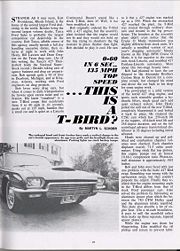

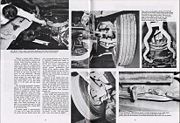
For 1964 the Thunderbird was restyled in favor of a more squared-off, "formal" look. The Thunderbird's sporty image had by that time become only an image. The standard 390-cubic-inch 300 bhp (224 kW) engine needed nearly 11 seconds to push the heavy T-bird to 60 mph (96 km/h), although with enough room a top speed of about 120 mph (200 km/h) was obtainable. The softly sprung suspension allowed considerable body lean, wallow, and float except on smoothly surfaced highways; there was an export suspension package available as special order. Contemporary testers felt that the Buick Riviera and Pontiac Grand Prix were substantially more road-able cars, but the Thunderbird remained the leader of the market segment.
The revised 'bird was initially offered as a hardtop, a convertible, or Landau, with vinyl roof and simulated landau irons. The tonneau cover and wire wheels of the Sports Roadster remained available as a dealer-installed option, although only 50 were sold from the factory. Total 1964 sales were excellent: 92,465, up nearly 50% from the previous year. The 1964 Thunderbird was the only car to have the word 'Thunderbird' on the front hood instead of the image of the Thunderbird.
Several features intended for the new generation were delayed until 1965, when front disc brakes became standard equipment and sequential turn signals were added. The latter feature flashed the individual segments of the broad, horizontal tail lights in sequences from inside to outside to indicate a turn. The delay resulted from legal difficulties with various U.S. state laws on vehicle lighting. Sales, impacted by increasing competition (including from Ford's own Mustang), dipped to 74,972.
For 1966 the 390-cubic-inch V8's power was increased to 315 bhp (235 kW). The larger 428-cubic-inch (7.0 L) V-8 became optional, rated at 345 gross horsepower (257.4 kW) and providing a notable improvement in 0-60 acceleration (to about 9 seconds). A new Town Hardtop model was offered, featured a roof with blind quarter panels for a more 'formal' look (at the cost of rear visibility). The Landau model was replaced by the Town Landau, which retained the previous model's padded roof and landau S-bars, but applied them to the Town Hardtop's formal roof. The Town Landau was by far the best-selling model, accounting for 35,105 of the 1966 model's 69,176 sales.
There was a very rare special order 427 available through certain Ford dealers for 1963-1965 Thunderbirds, 120 of these "high performance" models were made. Only six are still known to exist today. It is documented that Bob Tasca, a well known drag racer of the 1960s, ordered a factory-fitted 427 1964 Thunderbird with an export suspension and had custom body work done by Alexander Bros. Custom Shop in Detroit. The Birds Performance was said to do 0-60 mph in 6 seconds flat with a top speed of 135 mph (217 km/h). The car's current whereabouts are unknown. There is a link to another 427 Thunderbird at the bottom of this page.
A black 1964 convertible later had a major role in the TV series Highlander: The Series as protagonist Duncan Macleod’s main mode of transportation. A green 1966 Thunderbird convertible was prominently featured in the 1991 Ridley Scott film Thelma and Louise, starring Susan Sarandon and Geena Davis, a red 1966 Thunderbird convertible was featured in the 1983 film The Outsiders which was directed by Francis Ford Coppola, and a green 1966 Thunderbird Convertible was featured in the David Lynch film Wild at Heart, starring Nicholas Cage and Laura Dern.
1967-1969
 |
|
| Production | 1967-1969 |
|---|---|
| Assembly | Wixom, Michigan |
| Body style(s) | 2-door hardtop coupe 2-door landau 4-door pillared hardtop landau sedan |
| Engine(s) | 390 cu in (6.4 L) FE V8 428 cu in (7 L) FE V8 429 cu in (7 L) 385 V8 |
| Related | Lincoln Continental Mark III |
This fifth generation saw the second major change of direction for the Thunderbird. The Thunderbird had fundamentally remained the same in concept through 1966, even though the styling had been updated twice. The introduction of the Ford Mustang in early 1964 had, however, challenged the Thunderbird's market positioning. It, like the Thunderbird, was a small, two-door, four-seater with sporting pretensions, but it was substantially cheaper. The Thunderbird's sales suffered. Ford's response was to move the Thunderbird upmarket.
For 1967 the Thunderbird would be a larger car, moving it closer to Lincoln as the company chose to emphasise the "luxury" part of the "personal luxury car" designation. Ford chose to abandon the Thunderbird's traditional unibody construction for this larger car, turning to a body-on-frame method with sophisticated rubber mountings between the two to reduce vibration and noise.
The convertible, increasingly a slow seller, was dropped. Instead, the company introduced a four-door model. The rear doors were hinged on the edge to the rear of the vehicle (suicide doors), as on the 1960s Lincoln Continental. The four-door would remain available through 1971, but never generated substantial sales.
The new 1968 Lincoln Continental Mark III was based on the four-door Thunderbird chassis, and from that point until the late Nineties, Thunderbirds and Continental Marks were generally related cars, the Thunderbird following the Mark's growth to enormity in the 1972 model year. The Mercury Cougar also often shared components.
The 1967 design was radically different from what came before. Ford's stylists delivered a radical shape that in many ways anticipated the styling trends of the next five years. A gaping wide "fishmouth" front grille that incorporated hidden headlights was the most obvious new feature. The look was clearly influenced by the intakes on jet fighters such as the F-100 Super Sabre, and was enhanced by the flush-fitting front bumper incorporating the bottom "lip" of the "mouth". The sides were the barrel-like "fuselage" style that was very popular during this period. The belt line kicked up "coke-bottle" style after the rear windows, again a styling trait that would prove ubiquitous. Large C-pillars (and a small "formal" rear window on the 4-door) meant poor rear visibility but were the fashion of the time. The taillights spanned the full width of the car, and featured, as in previous Thunderbird models, sequential turn signals.
The 1968 Thunderbird saw the introduction of the new 385 series big-block 429 cu in (7 L) engines. Like most Ford motors of the time, they were "underrated" at 360 hp (268 kW) for insurance reasons. The Thunderbird motors also got special treatment with wedge style heads, making a significant power increase over their conventional headed brothers. These motors made the cars some of the quickest and fastest ever produced, despite their larger size and heavier body on frame construction. 1968 and 1969 model years saw minor trim changes respectively.
1970-1971
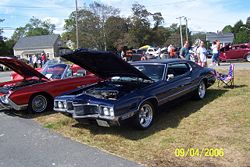 |
|
| Production | 1970-1971 |
|---|---|
| Assembly | Wixom, Michigan |
| Body style(s) | 2-door hardtop coupe 2-door landau 4-door pillared hardtop landau |
| Engine(s) | 429 cu in (7 L) 385 V8 |
| Related | Lincoln Continental Mark III |
Although sharing the same platform and many of the same parts of the 1967-69 models the 1970 Thunderbird saw a major change to its style: a big eagle's beak out front! Offered in coupe or sports-back models, all 1970-1971 Thunderbirds had prominent angular lines on the hood leading to a jutting tip, that also formed the center of the grill work, that was not a too thinly disguised bird beak. The T-bird for these two years had its most animalistic look that was fairly aggressive in appearance. Semon "Bunkie" Knudsen, the former GM man now President of Ford, is said to be responsible for this dramatic change,. As with the 1967-69 models, the 1970-71 models had sequential turn signals incorporated into the full panel tail lights in the rear of the vehicle.
In 1971, Neiman Marcus offered "his and hers" Thunderbirds in its catalog, with telephones, tape recorders and other niceties. They retailed for US$25,000 for the pair.
1972-1976
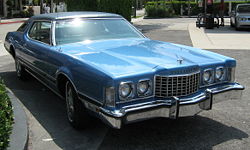 |
|
| Production | 1972-1976 |
|---|---|
| Assembly | Wixom, Michigan |
| Body style(s) | 2-door hardtop coupe |
| Engine(s) | 429 cu in (7 L) 385 V8 460 cu in (7.5 L) 385 V8 |
| Related | Lincoln Continental Mark IV |
Seventh generation Thunderbirds debuted in the fall of 1971. These were the biggest Thunderbirds produced, sharing a common body with the Lincoln Continental Mark IV. They rode on a 120.4-inch (3,058 mm) wheelbase, measured 225 inches (5,715 mm) overall by 1976. Prices rose also, with the 1976 Thunderbird listing at $7,790 without options. They used a massive 429 cu in (7 L) engine that was standard in 1972 and 1973 or the optional 460 cu in (7.5 L) engine, which was made standard for 1974 through 1976. These cars weighed around 5,000 pounds (2,268 kg). Due to their enormous proportions and large engines gas mileage was abysmal. These cars averaged anywhere from 8 mpg-US (29 L/100 km/9.6 mpg-imp) to 12 mpg-US (20 L/100 km/14 mpg-imp) depending on driving conditions. With the 1973 oil crisis taking its toll on the United States, automobiles were forced to downsize and become more efficient.
The 1972 Thunderbird represented a scaling down of body styles. Instead of the three body styles offered for the 1971 model year, Ford offered Thunderbird in only a two door hardtop form. The body shared many components with the new Lincoln Mark IV, the main differences being the front and rear ends. The prominent “beak” of 1971 was toned down and the full width tail lights lost the sequential turns signals of the previous cars. The interior was also shared with the Mark IV, the only difference being the dash. The 1972-76 dash utilized round gauges, speedometer, fuel gauge, and clock, as opposed to the Mark IV square gauges. To the driver’s left were the climate control controls and the light controls. To the right were the radio controls, wiper controls, and information center. This dash layout would remain through the 1976 model year. Base price was $5,293 and a total of 57,814 for the model year.
For 1973 Thunderbird would increase both in size and price. To accommodate the larger bumpers mandated for all 1973 automobiles, the front was restyled with an egg crate grill, topped by a spring loaded hood ornament, flanked by the quad headlight in individual nacelles. The turn signals were more prominent at the fender edges. Also new to the exterior were opera windows, first optional, then standard late in the model year. Power windows ($129), vinyl roof ($141), manual air conditioning ($436), and tinted glass ($51), were also made standard during the model year. Some new options included AM/FM 8-track tape player ($311), remote control right hand outside mirror ($26), and an anti-theft system ($79). Some optional equipment available included sure-track brakes, an early anti-lock braking system ($197), power sunroof ($504), power door locks ($59 ), cruise control ($103 ) and the 460 cu in (7.5 L) V8 ($76 ). 1973 was the last year for the 429 and leaded gas. Base price was $5,577 early in the model year and $6,414 later due to additions to the standard equipment list. A total of 87,269 Thunderbirds were built making this the third highest production figure to date.
1974 would see more changes made in response to new federal regulations. The only engine available was the 460 cu in (7.5 L) requiring unleaded fuel and the stronger bumpers in the rear. The full width taillights were replaced by four light segments separated by a central back-up light and the gas filler door was moved from behind the license plate to the drivers side rear panel. 1974 was the first year for special luxury group trim options, the burgundy luxury group ($411) and the white and gold luxury group ($546). These groups added upgraded paint and exterior and interior trim. Standard equipment remained unchanged but there were several new items listed as optional. Some of the most notable, and costly, included power moon roof ($798), auto lamp for automatic on/off of headlights ($34), and power mini-vent windows ($70). AM/FM stereo ($152) or with tape player ($311), power drivers seat ($105), dual power front seats ($210), rear window defroster ($85), power antenna ($31), automatic temperature control ($74), and front corning lights ($43) also appeared on the option list. Base price was $7,221 and 58,443 were produced for the model year.
Little changed for 1975 save new luxury groups and more items added to the standard equipment list. 1975 would have the most extensive list of standard equipment of any year Thunderbird from 1955 to 1997. Some items made standard this year were, AM/FM stereo, front corning lights, and front and rear stabilizer bars. The special editions luxury groups returned being named copper luxury group ($624), silver luxury group ($337), and jade luxury group ($624). The wide range options available changed little but four wheel disc brakes ($ 184) were available for the time. Power was still supplied by the 460 cu in (7.5 L) V8 rated at 220 horsepower (160 kW). Base price was $7,701 with a production of 42,685.
1976 was the last model year for the seventh generation. Some items that were standard in 1975 were moved to the options list. Some items returning to the option list included, AM/FM stereo, front cornering lights, and tinted glass. Additionally the rear windows became stationary. This move was to keep cost down and was also shared by the 1976 Mark IV. The 1976 luxury groups were crème and gold ($793 ), lipstick ($546 ), and Bordeaux ($700 ). New options included driver's lighted vanity mirror ($43), power lumbar drivers seat, ($86), AM/FM stereo search radio ($298), and AM/FM stereo radio with Quadra sonic 8-track tape player ($382). An auto dimmer was added to the autolamp option. Base price was $7,790 with a total of 52,935 cars produced.
1977-1979
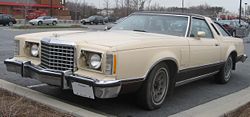 |
|
| Production | 1977-1979 |
|---|---|
| Assembly | Wixom, Michigan Chicago, Illinois Los Angeles, California |
| Body style(s) | 2-door hardtop coupe |
| Engine(s) | 302 cu in (4.9 L) Windsor V8 351 cu in (5.8 L) 351M V8 400 cu in (6.6 L) Cleveland V8 |
| Related | Ford LTD II Mercury Cougar |
For the 1977 through 1979 model years, the Thunderbird nameplate was shifted to the smaller 114" wheelbase chassis that underpinned the 1972-76 Ford Torino and its replacement, the concurrent 1977-79 LTD II, as Ford's first effort at downsizing the car. The squarer, sharper styling was popular, and this generation of Thunderbird sold well. Helped by a $2,700 drop in price from 1976, this generation was by far the most popular in Thunderbird history, with sales in excess of 300,000 units in both 1977 and 1978, almost 300,000 in 1979. In essence, this generation was really a continuation of the 1974-76 Ford Elite, Ford's successful first attempt at competing in the market created by the Pontiac Grand Prix and Chevrolet Monte Carlo.
Compared to the 1972-1976 T-Birds, the car lost 10 inches (254 mm) of length and 900 lb (408 kg) of weight, while height and width were essentially unchanged. A substantial part of the weight reduction was in the drivetrain, where a small-block V8 replaced the heavy big-block V8 of previous years.
The standard engine outside of California was the 302 cu in (4.9 L) Windsor V8, while the larger 351 cu in (5.8 L) 351M and 400 cu in (6.6 L) and T-tops were available as options along with the 351W. In California, the 351 was the only engine available. Although power was definitely down by 1977, the lighter car did compensate.
In 1978, Ford offered the "Diamond Jubilee Edition" Thunderbird to commemorate the company's 75th year as an auto manufacturer. This option package escalated the price of the car to almost US$12,000, virtually doubling the standard price. Naturally, it included every option available except for a moonroof and an engine block heater. It was originally available in only two colors- Diamond Jubilee exclusive "diamond blue" metallic, or "standard issue" ember metallic; both with matching velour cloth seats with a "biscuit" design. Later in production, Ford offered Leather as an option, and offered white as an exterior color with blue or white trim and interior. This option was available on the Continental Mark V as well for the much more substantial cost of US$23,000. In 1979, a similar option package was available named "Heritage". It included basically the same optional equipment, still with only two color options available: Heritage Maroon or Heritage Baby Blue. The "Heritage" option remained available into the next series of the car.
1980-1982
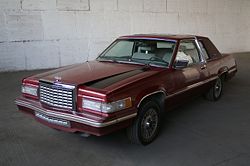 |
|
| Production | 1980-1982 |
|---|---|
| Assembly | Lorain, Ohio Chicago, Illinois Wixom, Michigan |
| Body style(s) | 2-door coupe |
| Platform | Ford Fox platform |
| Engine(s) | 200 cu in (3.3 L) Thriftpower Six I6 232 cu in (3.8 L) Essex V6 255 cu in (4.2 L) Windsor V8 302 cu in (4.9 L) Windsor V8 |
| Related | Ford Fairmont Ford Mustang Mercury Capri Mercury Cougar Mercury Zephyr Ford Granada |
1980 saw a new downsized Thunderbird that was an upmarket derivative of the Ford Fairmont sedan with nicer trim. The 1980 Thunderbird was a unibody car, weighing 800 lb (363 kg) less than the 1979 model, and was 17 in. (432 mm) shorter. It was based on the Fox platform, and the lighter weight resulted in better gas mileage.
These cars were not well received by the general public, and sales dropped off dramatically after 1980. The squarish upright lines favored by Ford design vice-president Eugene Bordinat, similar to the popular 1977-79 models, didn't translate well to the smaller platform.
The base engine was a 4.2 L (≈256 cu in) V8, or an optional 130 hp (97 kW) 4.9 L (302 cu in) Windsor V8. A 3.3 L (≈201 cu in) I6 was offered as a delete option in late built 1980 models and became the standard powerplant in 1981. The 3.8 L (≈232 cu in) V6 was made available as an option in 1982, and the 4.9 L (302 cu in) Windsor 5.0 V8 was dropped.
The 1980 and 1982 Thunderbirds offered vacuum operated hidden headlamps. Digital instrumentation was also available, along with a variety of trim packages. The 1980 Thunderbird was also among the first cars with a keyless entry keypad available. Recaro bucket seats were optional, and power windows were available. Though somewhat underpowered, they drove well, could easily keep pace with traffic on the open road, and offered considerable luxury in their size class.
1983-1986
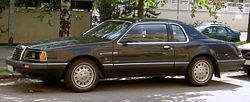 |
|
| Production | 1983-1986 |
|---|---|
| Assembly | Lorain, Ohio Wixom, Michigan |
| Body style(s) | 2-door coupe |
| Platform | Ford Fox platform |
| Engine(s) | 2.3 L Lima I4 (turbo) 3.8 L Essex V6 4.9 L Windsor V8 |
| Transmission(s) | 4-speed automatic 5-speed manual |
| Wheelbase | 104.2 in (2647 mm) |
| Length | 202.1 in (5133 mm) |
| Width | 71.1 in (1806 mm) |
| Height | 53.4 in (1356 mm) |
| Related | Ford LTD Ford Mustang Lincoln Continental Mark VII Mercury Capri Mercury Cougar Mercury Marquis |
| Designer | Jack Telnack |
1983 saw a much improved and aerodynamic car and the launch of the Turbo Coupe, and a much sportier image. Reputedly, in 1980 following a change in leadership, the new chief designer Jack Telnack was asked by executive Don Petersen "is this what you would want in your driveway?" Telnack's negative response prompted a redesign of the Thunderbird with the aero style that subsequently flowed on through the Taurus, Sierra and various Lincolns. In 1987, the Ford Thunderbird Turbo Coupe was redesigned and came with such notable features as automatic ride control, anti-lock brakes, and the intercooled turbocharged engine similar to that of the Ford Mustang SVO. All this resulted in a personal luxury car that produced 190 horsepower (140 kW) from a 2.3 L 4-cylinder engine and had a 143 mph (230 km/h) top speed. The Turbo Coupe was Motor Trend's Car of the Year for 1987.
The 1983 Ford Thunderbird was built on the same "Fox platform" as many other Ford products including the 1980-82 Thunderbird and the Ford Mustang. Unlike the previous generation T-Bird, the new-for-1983 model was redesigned with a more aerodynamic look. The drag coefficient of this body style was a mere 0.35. The 1983 T-Bird came in base, Heritage, and Turbo Coupe models. Both the base and the Heritage came standard with a 3.8 L (232 cu in) Essex V6 that produced 110 horsepower (82 kW) mated to a 3 speed automatic. A 4.9 L (302 cu in) Windsor 5.0 V8 with 140 horsepower (100 kW) was available with the former two models as well. The Turbo Coupe, the top-of-the-line model was special for several reasons. It used a turbocharged 4-cylinder 2.3 L (≈140 cu in) engine with Ford's EEC-IV electronic engine control system. Unlike the other models, the Turbo Coupe came with a standard 5-speed manual transmission. Other improvements included a limited-slip differential (called "Traction-Lok"), larger tires and wheels, and a sportier interior complete with analog gauges.
For 1984, the Thunderbird few changes were made. The Turbo Coupe gained a 3-speed automatic transmission as an option. A "FILA" model was available, which featured unique paint and wheel choices, as well as badging to provide the car a more European feel.
By 1985, the Turbo Coupe gained power to 155 horsepower (116 kW), and all models received a new interior. A 30th Anniversary Edition model was offered, that featured unique blue paint and stripes, and came very well loaded with options. It was loosely based on the Elan model and most models came with the V8. Minor changes were made in 1986, including a center high mount stop lamp, and the deletion of the FILA edition.
1987-1988
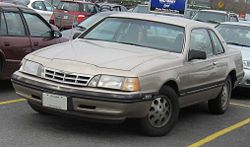 |
|
| Production | 1987-1988 |
|---|---|
| Assembly | Lorain, Ohio Wixom, Michigan |
| Body style(s) | 2-door coupe |
| Platform | Ford Fox platform |
| Engine(s) | 2.3 L (≈140 cu in) Lima I4 (turbo) 3.8 L (232 cu in) Essex V6 4.9 L (302 cu in) Windsor 5.0 V8 |
| Transmission(s) | 4-speed automatic 5-speed manual |
| Wheelbase | 104.2 in (2647 mm) |
| Length | 202.1 in (5133 mm) |
| Width | 71.1 in (1806 mm) |
| Height | 53.4 in (1356 mm) |
| Related | Ford LTD Ford Mustang Lincoln Continental Mark VII Mercury Capri Mercury Cougar Mercury Marquis |
| Designer | Jack Telnack |
By 1986, Ford was already hard at work on the so-called "MN12" project. Supposed to compete against the BMW 6-Series, Ford believed that the new Thunderbird would be too big a change for the public and still wanted to capitalize on the success that the previous generation of Thunderbirds had brought. So for 1987, the body shell and interior were altered, replacing the Elan were new LX and Sport models. The latter came with the V8 while the LX came with the V6. The Turbo Coupe earned the honor of being the Motor Trend Car of the Year for 1987. The 2.3 L turbo-4 now included the air-to-air intercooler that was found in the Ford Mustang SVO and boosted power up to 190 horsepower (140 kW) for the 5-speed manual transmission. New for the Turbo Coupe was a 4-speed automatic, with which the engine was rated at 150 horsepower (110 kW). The automatic had detuned turbo boost of 9.5 psi (65 kPa or 0.65 bar) instead of 10 to 15 psi (70 to 100 kPa or 0.7 to 1 bar). Ford's rationale for that was "transmission durability". Otherwise, the Turbo Coupe also came with anti-lock 4-wheel disc brakes, Automatic Ride Control, and 16-inch 225/60VR performance tires.
1988, the final year for the Turbo Coupe, saw only a minor change. The 5-speed manual transmission now allowed the full 15 psi of boost in all forward gears (as opposed to excluding the first two gears). The Turbo Coupe was replaced in 1989 by the Super Coupe which had a 3.8 L supercharged V6 engine—a radical departure from the old turbo-4.
1989-1997
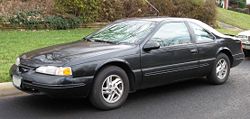 |
|
| Production | 1989-1997 |
|---|---|
| Assembly | Lorain, Ohio Wixom, Michigan |
| Body style(s) | 2-door coupe |
| Platform | Ford MN12 platform |
| Engine(s) | 3.8 L Essex V6 (NA/SC) 4.6 L Modular V8 (1994-1997) 4.9 L (302 cu in) Windsor 5.0 V8 |
| Transmission(s) | 4-speed automatic, 1989-1993 AOD, 1994-1997 4R70W |
| Wheelbase | 113. in (2870 mm) |
| Length | 1989-1993: 198.7 in (5047 mm) 1994-97: 200.3 in (5088 mm) |
| Width | 1989-1995: 72.7 in (1847 mm) 1996-97: 73.2 in (1859 mm) |
| Height | 1994-97: 52.5 in (1334 mm) 1994-95 Super Coupe: 53.0 in (1346 mm) 1989-1993: 52.7 in (1339 mm) 1991-93 Upper End Model: 53.1 in (1349 mm) |
| Curb weight | 3,701 lb (1,679 kg) |
| Related | Lincoln Mark VIII Mercury Cougar |

In 1989, a new, much-anticipated Thunderbird model premiered. Developed on Ford's new MN12 (Mid-Size North American Project 12) platform, the new Thunderbird featured a more aerodynamic body that was slightly shorter in overall length relative to the 1988 Thunderbird but had a nine inch longer wheelbase. The car featured a short-long arm (SLA) four-wheel independent suspension that offered excellent handling and ride quality. This setup was significant as it made the Thunderbird the only rear-wheel drive North American domestic car other than the Chevrolet Corvette to offer a four-wheel independent suspension at the time. Engine options fell to only two for 1989 as Ford dropped the V8 option for the new T-bird. The base and LX models were powered by Ford's 3.8 L Essex OHV V6. Producing 140 horsepower (100 kW) at 3800 RPM and 215 lb·ft (292 N·m) at 2400 RPM, many felt the engine was somewhat underpowered for the almost 3,800 pounds (1,700 kg) car. This engine was mated to Ford's AOD 4-speed automatic transmission regardless of trim level from the 1989 to 1993 model years. Thanks in part to its low coefficient of drag, the Thunderbird was relatively fuel efficient considering its overall size and weight. The EPA gave 1989 Thunderbirds equipped with the standard V6 a fuel efficiency rating of 19 mpg-US (12 L/100 km/23 mpg-imp) in city driving and 27 mpg-US (8.7 L/100 km/32 mpg-imp) on the highway, though, like most cars built before 2008, this rating was retroactively reduced by the EPA to reflect newer, more realistic fuel efficiency measurements.[1] The fuel efficiency rating was noticeably better than that of Thunderbirds equipped with higher performance engines and gave the base V6-equipped Thunderbird a significant driving range with its 19 gallon fuel tank (later decreased to 18 gallons).
A more sophisticated, supercharged and intercooled version of the 3.8 L OHV V6 was used to power the top-of-the-line Super Coupe. The Super Coupe could be had with the M5R2 5-speed, Mazda-derived manual transmission or the AOD 4-speed automatic transmission. The Thunderbird SC was Motor Trend's Car of the Year for 1989, which Ford proudly advertised. When running at a maximum of 5,600 RPM, the supercharger provided 12 psi of boost, producing 210 horsepower (160 kW) at 4000 RPM and 315 lb·ft (427 N·m) at 2600 RPM under a 8.2:1 compression ratio. Accompanying the more powerful engine, Super Coupes were equipped with a host of unique features underlining their higher performance demeanor relative to standard Thunderbirds. Among these were larger, 16x7 inch alloy wheels with high performance tires (standard Thunderbirds used a 15x6.5 inch wheel), a Traction-Lok locking differential, standard anti-lock brakes, lower bodyside cladding, fog lights, and a better handling suspension with an adjustable ride control supplied by Tokico.[2]
For the 1991 model year, Ford reintroduced a V8 option with the 4.9 L (302 cu in) Windsor 5.0 V8. The engine was used through the 1993 model year and produced 200 horsepower (150 kW) at 4000 RPM and 275 lb·ft (373 N·m) at 3000 RPM; gains of 35 horsepower (26 kW) and 25 lb·ft (34 N·m) respectively over the 1988 Thunderbird, the previous Thunderbird to use this engine. Like the standard 3.8 L Essex V6, the V8 was only mated to the AOD 4-speed automatic transmission. On the television program Motor Week in a review of the 1991 Thunderbird and similar Mercury Cougar, a road test of a V8-equipped Thunderbird revealed that the car could accelerate from zero to 60 MPH in 9.2 seconds; approximately two seconds faster than a standard V6 Thunderbird but about two seconds slower than a Super Coupe. [3]
In spite of the car's merits, it was considered a failure by some in management; it badly missed its weight and cost targets, and the higher price needed to pay for the improved features resulted in a big decrease in production volume compared with the previous model. The program manager was publicly criticized by Ford Chairman Harold A. Poling at the company's internal celebration of the Car of the Year award, and he resigned a short time later. The Lorain Assembly Plant reduced line speed from over 70 per hour to 40 per hour because of the reduced demand.
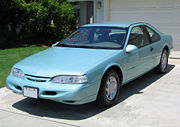
In 1994, the Thunderbird received some minor exterior updates. The hood, headlamps, and front fascia saw modest stylistic changes. At the center of this, the silver Thunderbird logo was moved onto the front bumper cover from the front lip of the hood where it was located previously. The Thunderbird's interior was completely redesigned with an emphasis on optimizing driver comfort and convenience to the utmost. The redesign featured a new steering wheel, radio, and climate controls with sweeping curves on the door panels and dashboard areas. Complimenting the changes to the interior came added safety as Ford made dual front-side airbags standard on all 1994 Thunderbird models.
Arguably the most dramatic change for 1994, however, was the new 4.6 L SOHC V8 which replaced the "5.0" Windsor engine. The 4.6 L V8 produced 205 horsepower (153 kW) at 4500 RPM and 265 lb·ft (359 N·m) at 3200 RPM and brought with it an updated powertrain control module, the EEC-V (base V6 Thunderbirds and Super Coupes continued to use the older EEC-IV). An electronically-controlled 4R70W 4-speed automatic transmission replaced the AOD automatic transmission in all instances where it was previously used in the Thunderbird. The Super Coupe continued on in 1994 with the same supercharged 3.8 L V6 as before, but now with 230 horsepower (170 kW) at 4400 RPM and 330 lb·ft (447 N·m) at 2,500 RPM. This was made possible due to a number of changes. The Eaton M90 roots-type supercharger was given a larger, square style inlet, a larger attaching inlet plenum, and Teflon coated rotors. The engine received larger fuel injectors and an increase in compression to 8.6:1. In their March 1996 issue, Motor Trend magazine conducted a comparison test of a 1995 Thunderbird SC against a Chevrolet Monte Carlo Z34 and a Buick Regal Gran Sport. The Super Coupe delivered the best overall performance, including a 0 to 60 mph acceleration time of 7.0 seconds and a completion of a quarter-mile in 15.2 seconds at 88.1 MPH. In summarizing the overall performance of each car relative to each other, the author of the article, Don Sherman, wrote, "The Buick Regal is a competent, comfortable car at an attractive price, but it's too androgynous to be called a Gran Sport. Nothing about it is grand, and there isn't a sporting bone in its body. All the Monte Carlo needs to succeed is a V-8 engine and a year of refinement to eradicate its quality bugs. That leaves the Thunderbird SC as this test's big winner. It's a far more sophisticated solution to the four-place-coupe equation, but is priced accordingly."[4] In spite of positive critiques like this, the increases in output and performance over earlier Super Coupes would be short-lived, as the Thunderbird SC was discontinued after the 1995 model year due to slow sales.

For the 1996 model year, the Thunderbird received its last refresh. Available in LX (V6 or V8) or Sport (V8 only) trims, the cars received redesigned headlights and taillights, smoother front and rear fascias, body side cladding, differently styled wheels (15 inch on LX, 16 inch on Sport), and a slight hood bulge, which was necessary to fit the updated 4.6 L engine's taller intake manifold, now composite. V8 models were tuned to make 205 horsepower (153 kW) at 4250 rpm and 280 lb·ft (380 N·m) at 3000 rpm, an increase of 15 lb·ft (20 N·m) over the 4.6 L V8s used in 1994 and 1995 Thunderbirds. In another comparison test conducted by Motor Trend against a Monte Carlo Z34, a Thunderbird with the updated 4.6 L V8 accelerated from zero to 60 MPH in 7.9 seconds and completed a quarter-mile run in 15.8 seconds at 88.4 MPH.[5] Unfortunately for owners, the all-composite intake had a tendency to crack and leak antifreeze. (Some 1997s are covered by a class action lawsuit settled by Ford late in 2005 - see Intake Manifold Defect for details.) The base LX model continued to use the 3.8 L V6 as its engine but now made use of the EEC-V computer which before was only found in 4.6 L V8-equipped models. Torque output from the V6 remained the same as before at 215 lb·ft (292 N·m) (though at 2750 RPM versus 2400 RPM) but power increased to 145 horsepower (108 kW) at 4000 RPM for 1996. In 1997, Ford made few notable changes, trying to save as much money as they could on the floundering coupe. As a result, the 1997 Thunderbird's appeal suffered, and the only options available were a power sunroof, power driver seat, remote keyless entry, and a CD player.
Also in 1997, high performance Thunderbirds were developed. Four prototypes produced by Ford's Special Vehicle Engineering division came with Cobra "R" brakes and wheels, a Tremec 5-speed manual transmission, and featured a 4.6 L DOHC V8 engine similar to that found in the SVT Mustang Cobra. The SVE Thunderbirds also came with a cowl hood to accommodate the Eaton supercharger sitting atop the modular motor. However, this high-performance Thunderbird was not to be, as Ford not only pulled the plug on this project, but on the entire Thunderbird/Cougar line to close the 1997 model year. The last MN12 Thunderbird rolled off the assembly line in Lorain, Ohio, on September 4, 1997.
2002-2005
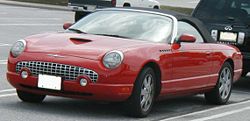 |
|
| Production | 2002-2005 |
|---|---|
| Assembly | Wixom, Michigan |
| Body style(s) | 2-door convertible |
| Platform | Ford DEW98 platform |
| Engine(s) | 3.9 L AJ35 V8 |
| Transmission(s) | 5-speed automatic |
| Wheelbase | 107.2 in (2723 mm) |
| Length | 186.3 in (4732 mm) |
| Width | 72 in (1829 mm) |
| Height | 52.1 in (1323 mm) |
| Related | Jaguar S-Type Lincoln LS |
However, 2002 saw a new Thunderbird launched; this was again a two-seater and received the model's fourth Motor Trend Car of the Year honor. It was also nominated for the North American Car of the Year award that year.
The new Thunderbird was based on the Ford DEW platform, shared with the Lincoln LS. It followed the recent trend for nostalgic recreations of old-fashioned (or "retro") styling (see Volkswagen New Beetle, Chrysler PT Cruiser, Chevrolet SSR, Plymouth/Chrysler Prowler), being a recreation of the 1955-1957 two-seat Thunderbird in a modern style. Available only as a convertible with a removable hardtop and, according to automotive writer Jerry Flint, the new Thunderbird "turned heads wherever it went."
The car had been intended for introduction during the 2001 model year but instead was delayed for a year. The 40,000 USD price tag was considered steep, given the car's rather average handling and power (although the handling and power were both commensurate with that of the original 2-seater Thunderbird). An initial run of 200 T-Birds were sold online by Neiman Marcus, and all sold out within 42 minutes. The 200 N-M cars were painted black, with the exception of the porthole hardtop, which was painted silver. Interior colors matched the exterior.
Ford expected sales of 25,000 units per year but, despite strong sales during its initial launch which saw dealers charging well over MSRP, this goal was never met. The 2002 Thunderbird sold 19,085 units and sales declined each subsequent year until its cancellation.
Forbes magazine writer Jerry Flint attributed significant blame of the latest generation Thunderbird's demise to a lack of proper sales and marketing, writing: "Ford dealers have been successful selling 35,000-45,000 USD trucks but have little experience selling automobiles in the near-luxury price range. If there was a marketing effort by Ford Motor, I wasn't aware of it. Naturally, sales didn't meet expectations."
Though the retro body styling never changed, exterior and interior color packaging was changed year to year. For 2002, the car was available in bright red ("torch red"), bright yellow ("inspiration yellow"), and turquoise ("Thunderbird blue"), all reminiscent of 1950s colors. Furthermore, "retro" two-tone interiors (black and the color matching the exterior), were paired with these exterior colors.
"Whisper white" and "evening black" exteriors were also available in 2002, with matching solid color interiors or the two-tone red interior. The black and red proved to be the models for the remaining years. Beginning with 2003, the two-tone "retro" interiors were sacked with the exception of red and a limited white, in favor of all-black (or other one-color) interiors. Gone were the bright yellow and turquoise exteriors, replaced with more subdued colors: "mountain shadow grey," "desert sky blue," and coral. Exterior and interior colors added for both the 2004 and 2005 model years remained subdued and white was replaced by platinum silver.
If Ford's tinkering with the exterior/interior packages were designed to boost sales, it didn't work, as sales continued to fall short of the company's hopes. Just 11,998 were sold in 2004. The Ford Motor Company announced in March 2005 that the Thunderbird would again be discontinued in July of that year, with 9,548 sold for 2005. Unlike previous T-birds, a 2nd row of seats were not added which might have widened its appeal, though Lincoln had the LS rather than an upscale Mark based on a Thunderbird platform.
The Thunderbird also shares the same odometer equipment as the Lincoln LS, a system which has caused confusion amongst the buying market. The LS odometer system utilizes a six-digit display including the 1/10 mile indicator. Upon initial inspection it appears as if Ford were returning to old fashioned odometers that simply reset after 99,999.9 miles, but instead the 1/10 mile indicator disappears and becomes a fraction-less odometer reading 100,000 thus forth.
There was also talk of a performance edition from Ford's SVT. a 2003 Concept, the Ford SuperCharged Thunderbird Concept which was designed by Sid Ramnarace featured a modified Jaguar Supercharged V8. Ford ultimately decided it was not necessary, though some Thunderbird fans believe it could have saved the car, both by improving performance and hearkening back to the Thunderbird's roots. The original 55-57 Thunderbirds came with several engine upgrades and were considered high performance cars of the day. Ford made no effort to give a performance image to the new Thunderbirds, and while the V-8 was competitively powered (280 hp (209 kW), 286 lb·ft (388 N·m)), its relatively heavy weight of over 3,700 lb (1,678 kg), widely spaced gears, and suspension that favored comfort over handling made it feel more akin to a large luxury car than a true sport coupe.
The 2003 Thunderbird was featured in the James Bond movie Die Another Day. Halle Berry's character of Jinx drove one in the movie. The mainly superficial design changes for the 007 edition Thunderbird were designed by Sid Ramnarace, including the Coral paint color which would become the basis for the Jinx character's wardrobe. Ford issued a limited edition which was produced to commemorate the movie.
In the last 50 years, some 4.2 million Thunderbirds have been sold.
Racing

During the 1980-1990s, the aerodynamically clean Thunderbirds were quite successful in NASCAR stock car racing before they were replaced by Taurus-based bodies.
References
- ↑ http://www.fueleconomy.gov/feg/calculatorCompareSideBySide.jsp?column=1andid=5728 United States. Environmental Protection Agency. Compare Old and New mpg Estimates: 1989 Ford Thunderbird. 19 Sep. 2008.
- ↑ "Thunderbird Super Coupe," Road and Track, 1988.
- ↑ "Motor Week". Host John H. Davis. Maryland Public Television. 1991.
- ↑ Sherman, Don. "Battle of the All-Americans." Motor Trend Mar. 1996:62-68.
- ↑ DeMere, Mac. "1996 Chevrolet Monte Carlo Z34 Vs 1996 Ford Thunderbird LX - Super Speed Way Fantasy." Motor Trend 1996.
- Automotive Mileposts, Inc. Ford Thunderbird. Retrieved on May 2, 2005.
- Flint, Jerry, "Ford's Thunderbird Gets Axed," Forbes.com, April 22, 2003.
- Gunnell, John A. (Ed.) (1987). Standard Catalog of American Cars 1946-1975, 2nd Edition. Krause Publications. ISBN 0-87341-096-3.
- 2004 Ford Thunderbird New Car Buyers Guide
- Wonder, William (1997). Thunderbird Restoration Guide 1958-1966, 1st Edition. MBI Publishing Company. ISBN 0-7603-0390-8.
- Harry Louis and Bob Currie, "The Story of Triumph Motorcycles", second edition 1978, publisher Patrick Stephens Limited
See also
- List of automobile model nameplates with a discontiguous timeline
|
|||||||||||||||||
| Ford road car timeline, North American market, 1946–1979 — next » | ||||||||||||||||||||||||||||||||||
|---|---|---|---|---|---|---|---|---|---|---|---|---|---|---|---|---|---|---|---|---|---|---|---|---|---|---|---|---|---|---|---|---|---|---|
| Type | 1940s | 1950s | 1960s | 1970s | ||||||||||||||||||||||||||||||
| 6 | 7 | 8 | 9 | 0 | 1 | 2 | 3 | 4 | 5 | 6 | 7 | 8 | 9 | 0 | 1 | 2 | 3 | 4 | 5 | 6 | 7 | 8 | 9 | 0 | 1 | 2 | 3 | 4 | 5 | 6 | 7 | 8 | 9 | |
| Subcompact | Pinto | Pinto | Pinto | |||||||||||||||||||||||||||||||
| Fiesta | ||||||||||||||||||||||||||||||||||
| Compact | Falcon | Falcon | Falcon | |||||||||||||||||||||||||||||||
| Maverick | Fairmont | |||||||||||||||||||||||||||||||||
| Mid-size | Fairlane | Fairlane | Fairlane | Fairlane | Granada | |||||||||||||||||||||||||||||
| Torino | Torino | Torino | LTD II | |||||||||||||||||||||||||||||||
| Full-size | Ford | Ford | Ford | Fairlane | LTD | LTD | LTD | LTD | ||||||||||||||||||||||||||
| Galaxie | Galaxie | Galaxie | Galaxie | Galaxie | ||||||||||||||||||||||||||||||
| Custom | Custom | Custom | Custom | |||||||||||||||||||||||||||||||
| Luxury | Thunderbird | Thunderbird | Thunderbird | Thunderbird | Thunderbird | Thunderbird | Thunderbird | |||||||||||||||||||||||||||
| Sports | Thunderbird | Mustang | Mustang | Mustang | Mustang | Mustang II | Mustang | |||||||||||||||||||||||||||
| « previous — Ford road car timeline, North American market, 1980s–present | ||||||||||||||||||||||||||||||
|---|---|---|---|---|---|---|---|---|---|---|---|---|---|---|---|---|---|---|---|---|---|---|---|---|---|---|---|---|---|---|
| Type | 1980s | 1990s | 2000s | |||||||||||||||||||||||||||
| 0 | 1 | 2 | 3 | 4 | 5 | 6 | 7 | 8 | 9 | 0 | 1 | 2 | 3 | 4 | 5 | 6 | 7 | 8 | 9 | 0 | 1 | 2 | 3 | 4 | 5 | 6 | 7 | 8 | 9 | |
| Subcompact | Fiesta | Festiva | Aspire | |||||||||||||||||||||||||||
| Compact | Pinto | Escort | Escort | Escort | ||||||||||||||||||||||||||
| Fairmont | Tempo | Tempo | Contour | |||||||||||||||||||||||||||
| Focus | Focus | |||||||||||||||||||||||||||||
| Mid-size | Granada | LTD | Fusion | |||||||||||||||||||||||||||
| Taurus | Taurus | Taurus | Taurus | |||||||||||||||||||||||||||
| Full-size | Five Hundred | Taurus | ||||||||||||||||||||||||||||
| LTD | LTD Crown Victoria | Crown Victoria | Crown Victoria | |||||||||||||||||||||||||||
| Luxury car | Thunderbird | Thunderbird | Thunderbird | Thunderbird | ||||||||||||||||||||||||||
| Sport compact | EXP | EXP | Probe | Probe | Escort ZX2 | ZX2 | ||||||||||||||||||||||||
| Sports | Mustang | Mustang | Mustang | |||||||||||||||||||||||||||
| GT | ||||||||||||||||||||||||||||||